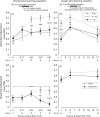A neonicotinoid impairs olfactory learning in Asian honey bees (Apis cerana) exposed as larvae or as adults
- PMID: 26086769
- PMCID: PMC4471740
- DOI: 10.1038/srep10989
A neonicotinoid impairs olfactory learning in Asian honey bees (Apis cerana) exposed as larvae or as adults
Abstract
Xenobiotics such as the neonicotinoid pesticide, imidacloprid, are used globally, but their effects on native bee species are poorly understood. We studied the effects of sublethal doses of imidacloprid on olfactory learning in the native honey bee species, Apis cerana, an important pollinator of agricultural and native plants throughout Asia. We provide the first evidence that imidacloprid can impair learning in A. cerana workers exposed as adults or as larvae. Adults that ingested a single imidacloprid dose as low as 0.1 ng/bee had significantly reduced olfactory learning acquisition, which was 1.6-fold higher in control bees. Longer-term learning (1-17 h after the last learning trial) was also impaired. Bees exposed as larvae to a total dose of 0.24 ng/bee did not have reduced survival to adulthood. However, these larval-treated bees had significantly impaired olfactory learning when tested as adults: control bees exhibited up to 4.8-fold better short-term learning acquisition, though longer-term learning was not affected. Thus, sublethal cognitive deficits elicited by neonicotinoids on a broad range of native bee species deserve further study.
Figures

References
-
- Lonsdorf E. et al. in Natural capital: theory and practice of mapping ecosystem services (Karieva P., Tallis H., Ricketts T., Daily G. C. & Polasky S. ) 168–187 (Oxford University Press, 2011).
-
- Potts S. G. et al. Global pollinator declines: trends, impacts and drivers. Trends Ecol. Evol. (Amst.) 25, 345–353 (2010). - PubMed
-
- Pimentel D. & Burgess M. Environmental and economic costs of the application of pesticides primarily in the United States in Integrated pest management (eds Pimentel D. & Peshin R. ) 47–71 (Springer 2015).
-
- Encinas-Viso F., Revilla T. A. & Etienne R. S. Shifts in pollinator population structure may jeopardize pollination service. Journal of Theoretical Biology 352, 24–30 (2014). - PubMed
-
- Whitehorn P. R., O’Connor S., Wackers F. L. & Goulson D. Neonicotinoid pesticide reduces bumble bee colony growth and queen production. Science 336, 351–352 (2012). - PubMed
Publication types
MeSH terms
Substances
LinkOut - more resources
Full Text Sources
Other Literature Sources

